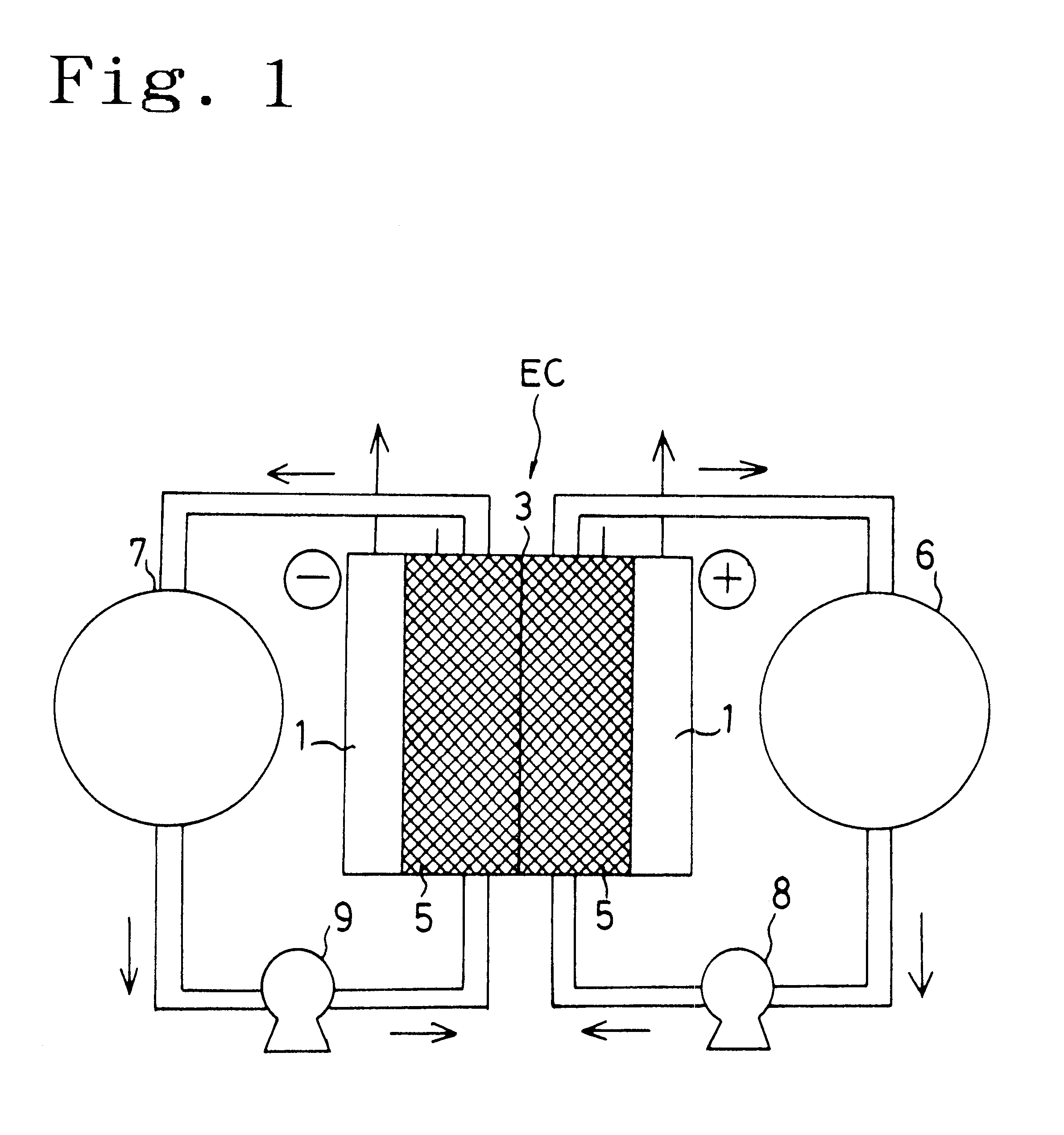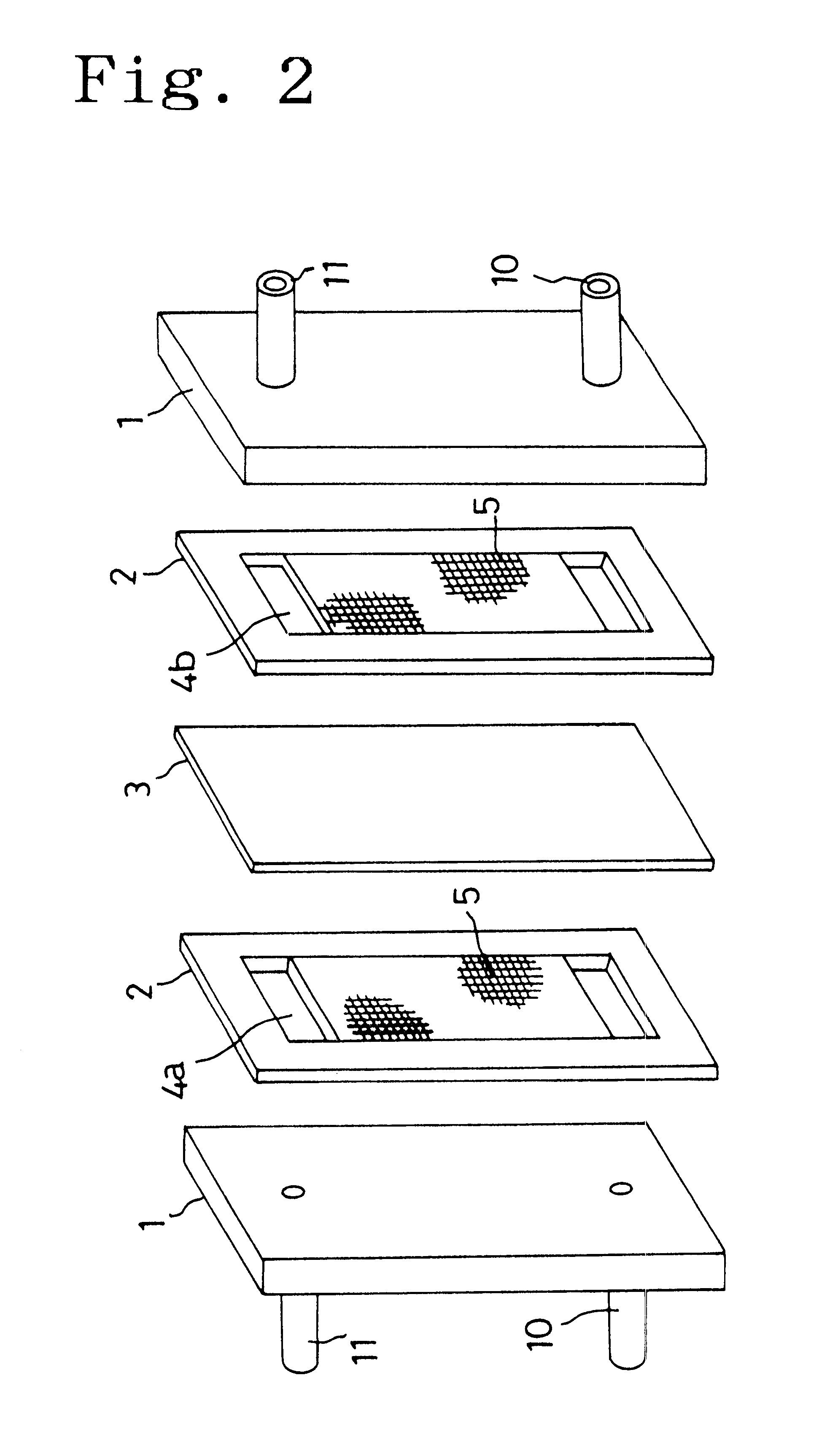Carbon electrode material for a vanadium-based redox-flow battery
a technology of vanadium-based redox flow and carbon electrode material, which is applied in the direction of non-aqueous electrolyte cells, cell components, electrochemical generators, etc., can solve the problems of small reaction amount per unit volume, and inability to achieve high energy efficiency
- Summary
- Abstract
- Description
- Claims
- Application Information
AI Technical Summary
Problems solved by technology
Method used
Image
Examples
example 1-1
After a polyacrylonitrile fiber having the average fiber diameter of 16 .mu.m was converted into flame-resistant in an air at 200 to 300.degree. C., a short fiber of the flame-resistant fiber (length; about 80 mm) was felted to make a non-woven fabric having basis weight of 400 g / m.sup.2 and the thickness of 4.0 mm. While an argon gas was constantly blasted to the non-woven fabric at 600 cc / min. / m.sup.2, a temperature was raised to 1400.degree. C., 1600.degree. C. or 1800.degree. C., respectively, at a temperature raising rate of 100.degree. C. / min. and a temperature was maintained at the each temperature for 1 hour to perform carbonization. Thereafter, the non-woven fabric was cooled, and treated in the nitrogen gas atmosphere having the oxygen concentration of 7% at 700.degree. C. to yield by weight of 95% to obtain three kinds of carbonaceous fibrous non-woven fabrics.
example 1-2
After a mesophase pitch fiber having the average fiber diameter of 13 .mu.m was made infusible in an air at 250 to 350.degree. C., a short fiber of the infusible fiber (length; about 80 mm) was felted to make a non-woven fabric having basis weight of 500 g / m.sup.2 and the thickness of 5.5 mm. While an argon gas was constantly blasted to the non-woven fabric at 600 cc / min. / m.sup.2, a temperature was raised to 1200.degree. C. at a temperature raising rate of 100.degree. C. / min. and a temperature was maintained at that temperature for 1 hour to perform carbonization. Thereafter, the non-woven fabric was cooled, and treated in the nitrogen gas atmosphere having the oxygen concentration of 7% at 700.degree. C. to yield by weight of 95% to obtain the carbonaceous fibrous non-woven fabric.
example 1-3
A non-woven fabric made under the same conditions as those of Example 1-1 was heated to 1400.degree. C. at a temperature raising rate of 10.degree. C. / min. in the nirogen gas atmosphere, maintained at that temperature for 1 hour to perform carbonization, cooled, and treated in the nitrogen gas atmosphere having the oxygen concentration of 7% at 700.degree. C. to yield by weight of 95% to obtain the carbonaceous fibrous non-woven fabric.
PUM
| Property | Measurement | Unit |
|---|---|---|
| size | aaaaa | aaaaa |
| size | aaaaa | aaaaa |
| size | aaaaa | aaaaa |
Abstract
Description
Claims
Application Information
 Login to View More
Login to View More - R&D
- Intellectual Property
- Life Sciences
- Materials
- Tech Scout
- Unparalleled Data Quality
- Higher Quality Content
- 60% Fewer Hallucinations
Browse by: Latest US Patents, China's latest patents, Technical Efficacy Thesaurus, Application Domain, Technology Topic, Popular Technical Reports.
© 2025 PatSnap. All rights reserved.Legal|Privacy policy|Modern Slavery Act Transparency Statement|Sitemap|About US| Contact US: help@patsnap.com



